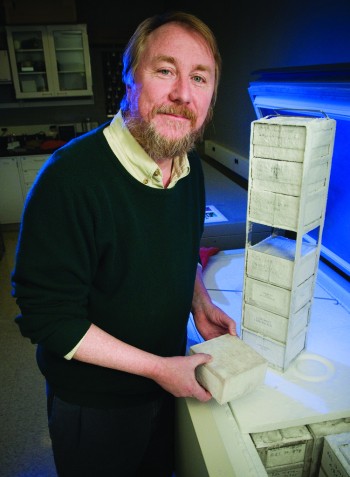Long-term evolution experiment informs how the coronavirus evolves
In 1988, Richard Lenski, a thirty-one-year-old biologist at UC Irvine, started an experiment. He divided a population of a common bacterium, E. coli, into twelve flasks. Each flask was kept at thirty-seven degrees Celsius, and contained an identical cocktail of water, glucose, and other nutrients. Each day, as the bacteria replicated, Lenski transferred several drops of each cocktail to a new flask, and every so often he stored samples away in a freezer. His goal was to understand the mechanics of evolution. How quickly, effectively, creatively, and consistently do microorganisms improve their reproductive fitness?

Lenski’s flasks produced about six new generations of E. coli a day; the bacteria woke up as babies and went to bed as great-great-great-grandparents. In this way, Lenski and his team have studied more than seventy thousand generations of E. coli over thirty-three years. Compared with their distant ancestors, the latest versions of the bacterium reproduce seventy per cent faster; it once took them an hour to double their ranks, but now they can do it in less than forty minutes. Different populations have taken different paths to enhanced fitness, but, after decades, most have arrived at reproduction rates within a few percentage points of one another.
Lenski’s Long-Term Evolution Experiment, or L.T.E.E., as it’s called, has yielded fundamental insights into the mutational capabilities of microorganisms. For his work, Lenski, now in his sixties and at Michigan State University, has received a MacArthur “genius” grant and a Guggenheim Fellowship. “I’m not sure I can tell you how it’s affected my thinking, because I’m not sure I can conceive of being in this field without this experiment existing,” Michael Baym, an evolutionary biologist at Harvard Medical School, recently told Discover.
Three of the experiment’s key findings are especially relevant today. The first is that, in general, there were diminishing returns to mutation over time: the bacteria made many of their most reproductively advantageous moves early on. A second finding, however, was that the bacteria never stopped getting fitter. Seventy thousand generations in, they’re still finding new ways to improve, albeit at a somewhat slower rate. “I had sort of imagined that things would have flatlined,” Lenski told me recently, when we spoke over Zoom. “But there seem to be endless possibilities for tinkering and progress. If there is a hard limit, it’s so, so far away that it’s impractical to consider on an experimental timescale—maybe even a geological timescale.”
Lenski has a friendly, expressive face, with pale blue eyes and a neat beard; his voice pulses with excitement when he considers a provocative question or explains the implications of his research. He told me about a third major finding: in 2003, some fifteen years and thirty thousand generations into the experiment, Lenski arrived at his lab to find that, overnight, a flask that was normally fairly translucent had turned cloudy. The bacteria it contained had experienced an explosive surge in growth. Normally, E. coli eat mainly glucose, but this population had unlocked an entirely new source of energy: a chemical compound called citrate. The capacity to metabolize citrate is so unusual that no population in the study had developed it until that point, and none have attained it since. It’s as if a family of humans could suddenly drink salt water.
The emergence of a citrate-eating lineage suggests that exceptionally rare, profoundly consequential evolutionary leaps are possible long after the low-hanging fruit has been picked. “How can something like this happen, and yet be so rare that it never happens again?” Lenski asked. “One possibility is that you have a super-rare mutation that is just so unique that it’s only happened once in the entire history of this experiment. Alternatively, maybe you need a whole set of earlier changes, so that you set up a genetic background where an ordinary mutation can allow this new function. I think it’s both: this was an unusual mutation, and it could only produce growth on citrate because there were specific genetic changes that preceded it.”
Sars-CoV-2, the virus that causes covid-19, has already had one citrate moment: the instant, probably sometime in 2019 but possibly earlier, when it developed the ability to leap into humans. Since then, the virus has accumulated innumerable mutations, some of which allow it to generate copies of itself more efficiently—by altering how it binds to our cells, for instance, or by finding new ways to slip past our immune systems. It’s a process that has occurred with every infectious disease in history—measles, tuberculosis, bubonic plague, influenza, and untold others. The difference with the coronavirus is that the world is now watching every mutational move as it happens.
During this pandemic, we’ve developed and deployed vaccines in real time. Meanwhile, sars-CoV-2 is replicating not in a dozen flasks but in tens of millions of people, some of whom have been immunized, all of whom exert selective pressure for the virus to find new, more efficient replication strategies. The virus will continue to mutate every moment of every day, for years, for decades. The fear is that it will hit upon a second citrate moment: a mutation, or set of mutations, that enables it to circumvent our vaccines, which so far have proved spectacularly effective and resilient. For those who remain unvaccinated—the majority of humankind—there is also the horrifying prospect of a variant that is vastly more contagious or deadly. Every few months, we learn of a version of the virus that seems somehow worse: Alpha, Beta, Gamma, Delta. The coronavirus appears destined to march its way through the Greek alphabet—a prizefighter getting quicker, slicker, stronger with each opponent. What are the limits to its evolutionary fitness? Are they knowable? And, if so, how close are we to reaching them?



